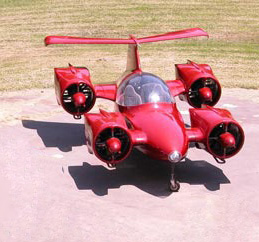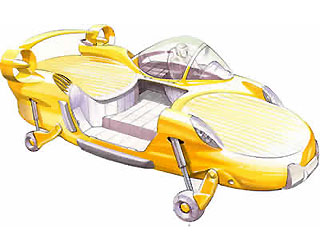
A flying car or roadable aircraft is a type of vehicle which can function both as a road vehicle and as an aircraft. As used here, this includes vehicles which drive as motorcycles when on the road. The term "flying car" is also sometimes used to include hovercars and/or VTOL personal air vehicles. Many prototypes have been built since the early 20th century, using a variety of flight technologies. Most have been designed to take off and land conventionally using a runway. Although VTOL projects are increasing, none has yet been built in more than a handful of numbers.

The Moller Skycar is a flying car with VTOL capability which has been under development by Paul Moller for over fifty years. As of 2023, the M400 has not achieved free flight.

Powered paragliding, also known as paramotoring or PPG, is a form of ultralight aviation where the pilot wears a back-pack motor which provides enough thrust to take off using a paraglider. It can be launched in still air, and on level ground, by the pilot alone—no assistance is required.

The Learjet 23 is an American six-to-eight-seat twinjet, high-speed business jet manufactured by Learjet. Introduced in 1964, it was Learjet's first model and created a new market for fast and efficient small business aircraft. Production ended in 1966 after 101 aircraft had been delivered.

The Urban Aeronautics X-Hawk is a proposed flying car designed by Rafi Yoeli in Yavne, Israel, being built by Metro Skyways Ltd., a subsidiary of Yoeli's privately held company, Urban Aeronautics. The firm claims to have flown the car to a height of 90 cm (3 ft), and that greater heights are possible. The X-Hawk and its smaller unmanned version, the Tactical Robotics Cormorant, would be used in search and rescue operations where a helicopter would be useless, or at least very dangerous, such as evacuating people from the upper stories of burning buildings, or delivering and extracting police and soldiers while very close to structures, narrow streets, and confined spaces, with a projected size similar to that of a large van.

The Piasecki VZ-8 Airgeep was a prototype vertical takeoff and landing (VTOL) aircraft developed by Piasecki Aircraft. The Airgeep was developed to fulfill a U.S. Army Transportation Research Command contract for a flying jeep in 1957. The flying jeep was envisioned to be smaller and easier to fly than a helicopter.

The M200G Neuera is a prototype of a flying saucer-style hovercraft, designed by aeronautics engineer Paul Moller. The vehicle is envisioned as a precursor to the Moller M400 Skycar. The M200G Volantor uses a system of eight computer-controlled fans to hover up to 10 feet (3 m) above the ground. Volantor is a term coined by Moller meaning "a vertical takeoff and landing aircraft."
The LaBiche Aerospace FSC-1, a.k.a. LaBiche 460sc, is a prototype roadable aircraft and is an example of a practical flying car capable of utilizing today's automotive and aviation infrastructure to provide true "door-to-door" travel.

The Terrafugia Transition is a light sport, roadable airplane under development by Terrafugia since 2006.

The Stout Skycar was a series of four one-off American light aircraft of the 1930s.

The Convair Model 116 ConvAirCar was a prototype roadable aircraft that was intended to exploit the post-war aviation market. The vehicle was further developed into the Convair Model 118, but neither type achieved production status.

The OMA SUD Skycar is an Italian twin-engined five-seat piston-engined pusher configuration monoplane designed and built by OMA SUD SpA based in Capua.
The Daiichi Kosho Whisper is a Japanese paramotor that was designed and produced by the Daiichi Kosho Company for powered paragliding.

The Samson Switchblade is an American amateur-built roadable aircraft, under development by Samson Motorworks of Meadow Vista, California. It was publicly introduced at AirVenture in 2009 in mock-up form. The aircraft is intended to be supplied as a kit for amateur construction initially and possibly as a complete ready-to-fly-aircraft in the future.
The EasyUp Parapropter is an American paramotor that was designed by Tom Tate and produced by EasyUp of Medford, Oregon. Now out of production, when it was available the aircraft was supplied in the form of blueprint-style plans and an instruction manual for amateur construction. A kit was also available at one time.
The Personal Flight Sky-Bike is an American paramotor that was designed and produced by Personal Flight of Kent, Washington for powered paragliding. Now out of production, when it was available the aircraft was supplied as a kit for amateur construction.

The Lilium Jet is a prototype German electric vertical take-off and landing (eVTOL) electrically powered airplane designed by Lilium GmbH. A seven-seat production version is planned.

The Airbus Vahana was an electric-powered eight-propeller VTOL personal air vehicle prototype financed by A³, by Airbus and Airbus Urban Mobility. The Vahana project started in 2016 as one of the first projects at A³, the advanced projects and partnerships outpost of Airbus Group in Silicon Valley. Airbus "envision[s] Vahana being used by everyday commuters as a cost-comparable replacement for short-range urban transportation like cars or trains". It was planned to be a part of urban air mobility. The project was finished in December 2019.

Neil Adrian Denis Laughton is a former army officer, entrepreneur and adventurer. He has completed the Explorers Grand Slam of climbing the highest mountains on all seven continents and reaching both the North and South Poles. He holds a number of records for his activities on land, sea and air.
SkyDrive is a eVTOL company based in Toyota City, Aichi Prefecture, Japan.















